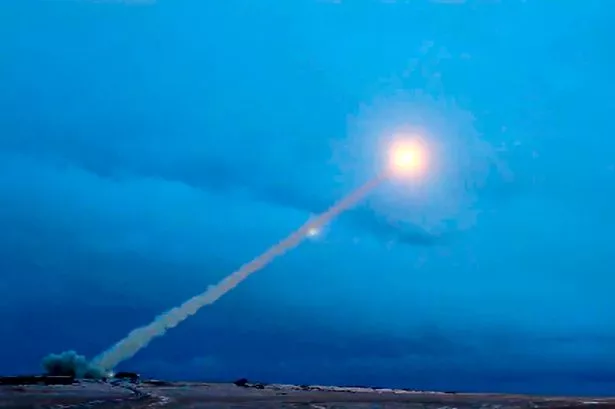Russia President Vladimir Putin unveiled the Burevestnik nuclear missile in 2018 and increased activity at the Pankovo test site has fuelled suspicions of an imminent test
Vladimir Putin is feared to have green lighted new tests for his “Flying Chernobyl” nuclear missile, which is supposedly capable of flying for days or even weeks on end as it probes weaknesses in Western defences.
The “miracle” Burevestnik was originally announced by Putin in 2018 but more than a dozen tests so far have been deemed failures. The super weapon has previously been described as “a radically new type of weaponry” with “unlimited range and unlimited ability to manoeuvre”.
Increased activity at the Pankovo test site on the Novaya Zemlya archipelago in the Arctic has fuelled suspicions of an imminent test, according to Decker Evelet, a nuclear weapons expert at the CNA analytical company. It comes after Putin warns of nuclear war after unleashing another night of hell on Ukraine.
READ MORE: NATO scrambles warplanes as Russia shoots down West’s F-16 fighter jet in Ukraine onslaughtREAD MORE: Donald Trump’s mental state ‘clear to see’ as lawmakers urged to ‘act now’
The US also recently sent a WC-135R radiation reconnaissance aircraft of the Air Force to Novaya Zemlya, which suggests a possible test could be imminent, according to the independent Moscow Times. The aircraft – which is equipped with sensors to track nuclear tests – flew from RAF Mildenhall in Suffolk for about 14 hours over the Barents Sea, and close to the coast of Russia’s Murmansk region, west of Novaya Zemlya.
Russia has made multiple attempts to test the unlimited range Burevestnik – also known as Skyfall – none of which have been successful. The Burevestnik’s longest flight was only around 22 miles, lasting two minutes.
In 2019, the Burevestnik notoriously crashed into the Barents Sea, and a retrieval operation led to an explosion that killed seven scientists from the closed nuclear city Sarov, triggering radiation in Scandinavia. Putin dubbed them “national heroes” without explaining details of their deaths.
Last year traces of radioactive Cesium-137 were measured along Norway’s border with Russia, leading to unconfirmed concerns over activity at the Pankovo test site for the Burevestnik. The readings were from analysis of filters from Viksjøfjell and Svanhovd in Norway.
The Burevestnik is viewed by the Russian dictator as a game-changing ‘doomsday’ weapon with an unlimited range. It is seen by the Kremlin as a low-flying “stealth” cruise missile incapable of interception by existing Western air defences and delivering nuclear warheads anywhere around the globe.
A report by the Nuclear Threat Initiative – a non-profit arms control group – said Russia had conducted 13 known tests between 2017 and 2019, all of which were unsuccessful. It is called the “Flying Chernobyl” because it emits radioactive exhaust due to its unshielded or partially shielded reactor, raising ecological and safety concerns. The nickname relates to the Chernobyl Nuclear Power Plant explosion in 1986.
The Burevestnik is believed to be launched by a solid-fuel rocket motor. Then a small nuclear reactor activates in flight, which potentially allows it to stay aloft threatening Western countries almost indefinitely.
The nuclear weapon was among a group of “doomsday” weapons unveiled by Putin in March 2018, alongside the Poseidon nuclear torpedo, Kinzhal hypersonic missile, Avangard glide vehicle, and the Sarmat – or Satan-2 – giant nuclear rocket.



